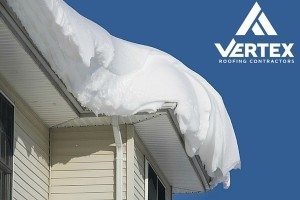
Common Winter Roofing Problems You May Experience in Utah
One of the most difficult seasons for your roof is during the winter months. This is due to the ways in which the heavy snow, ice, sleet, and frigid winds can damage residential roofs and commercial roofs alike. With that said, the following is an overview in terms of how to solve the biggest winter roofing dilemmas.
Ice Dams
Ice dams are large humps of ice that form at the edge of the roof, during times of frigid winter air and or high precipitation. They form due to having a roof that is warm enough to melt the ice and snow and trickles down until it reaches the still frozen eave of the roof, which remains cold due to the fact that it extends beyond the side of the house. The melted ice, then begins to collect on the eave, slowly created a huge mound of ice. With the propensity to cause massive damage, effectively dealing with ice dams is essential to maintaining a fully functional roof.
In order to eliminate ice dams, tap the block lightly with a blunt mallet and allow smaller chunks to fall to the ground. You can also install a water-repellent membrane under any new roof. On the flip side, in order to prevent ice dams from forming to begin with, seal all points on the roof from which warm air leaks, Insulate the living space to prevent the roof from becoming overheated, and vent the space between the insulation and roof sheathing so that any heat that sneaks through can easily escape.
Condensation
Next, condensation occurs when moisture develops on areas of the roof ceiling that are trapped by barriers of foil insulation and, due to an array of reasons, the roof cells are unable to vent in order to allow the moisture to dry out. The main solution for this issue is maintaining proper roof ventilation. With an array of roof cavity vents available, simply select the one that is most suitable for your home, and have it installed by a professional.
Snow and Icy Build-Up
Similar to roof dams, snow and ice build-up consists of piles of snow and ice building up on various areas of the roof. You can prevent this issue from becoming a major problem in the following ways:
- Use a rake immediately after storms to eliminate the possibility of build-up over time
- Remove as much ice from the gutter as safely possible
- Install a snow melting system on your roof
- Also, remember leaks in your roof should be addressed immediately
Flashing Leaks
Leaks caused by holes and leaks within the metal roof flashing, flashing leaks are fairly simple to fix. By simply locating all of the holes, plugging the holes with roofing cement, and patching each with the same material used for the flashing. In addition, keep in mind that flashing that has been too badly damaged will need to be replaced altogether. In order to prevent this, stay on top of roof dams as they can cause these leaks and also be sure your flashing is well maintained.
Shingle Damage
Yet another problem caused by ice dams, shingle damage occurs when melted water backs up behind an ice dam and begins to seep underneath the shingles. This can eventually cause massive damage to the sheetrock, paint, and many other areas. In order to address this, be sure to follow the instruction on preventing and eliminating ice dams.
Poorly Insulated Attic
Lastly, attics with poor ventilation can directly cause issues such as mold, rust, ice dams, frost, and much more. One of the best ways to prevent this matter is to address air leaks in your attic.
 Overall, the best way to address any major roofing issue is to contact a professional. Vertex Roofing Contractors offers well-trained professionals as well as a 50-year workmanship guarantee. You have nothing to lose but a leaky roof. Contact us today!
Overall, the best way to address any major roofing issue is to contact a professional. Vertex Roofing Contractors offers well-trained professionals as well as a 50-year workmanship guarantee. You have nothing to lose but a leaky roof. Contact us today!

